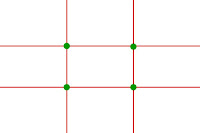Directors plan every frame, shot and sequence. Some terms are:-
- Frames
- Shots
- Sequences
- Scenes
- Movies and Programmes
- FRAME- is a single cell of a film. In film making 24 frames make up a second. So real time film is 24 frames per second (fps). In video if you wish to shoot real time you will need to shoot 25 fps.
- SHOT- a shot is a continuous strip of motion picture film, created of a series of frames, that runs for an uninterupted period of time.
- SCENE- is a part of the action that happens in a single location. As soon as the location changes it is the start of the new scene.
- SEQUENCE- is a series of scees which form a distinct narrative unit, usually connected either by a location or a unit or passage of time. They can also follow a narrative and usually have a beginning a middle and an end of some description.
- A MOVIE (FILM) OR PROGRAMME- are an entire bodies of work. They are created through series's of shots, frames, scenes and sequences.
Shot Sizes
They are a variety of shot sizes form extreme close up (ecu) to a very long shot/wide shot (vls). Different shots serve a different purpose and can be used to show the viewer the desired information. Generally when filming you start away from the action (ls) and then gradually move closer (cu) drawing the viewer into the scene and the action. A vls is a very good shot for establishing where you are and what maybe going on. Shot sizes communicate infomation, emotion and details of the intended meaning of the director. To establish a location or setting it is best to use a wide shot so the viewer can drink in all the general information. As there is a lot of information, it needs to be on screen for a while. If the communication or highlight something of the intrest to the viewer shuch as an important prop or character emotion they are likely to use a close up. These need less time on screen as there is less to take in.
Rule of thirds
The rule of thirds is a fundimental rule of compostition that objects placed off centre are more interesting to look at. A grid is imagned over the frame (like naughts and crosses) and generally the eyes are on the top line (eye line) the horizon on the bottom (horizon line) and the subject on either of the two horizontal lines. The sweet spots are where the lines intersect and where you want to place the subject. Consider looking/moving space.

180° Line Rule: line of action
An imaginary line you must not cross or the action is inconsistent when you cut together the edit.
Position 1: Camera below the line action is moving from right to left in the shot.
Position 2: Camera above the line action is moving from left to right in the shot.
If you edit from 1-2 then the action makes no sense as the subject changes direction. You must always film the action form one-side of the 180° degree line or your action will not edit properly and the movement in the shot will simply not work. The only exception is if you cross the line during a shot by moving the camera accross the line during a tracking type shot.

Camera Angle
High angle shots make the subject of the shot seem weak and inferior. Low angle shots make the shubject seem strong and powerful and viewer feels inferior. Canted angle or Dutch tilt shots make the fram seem awkward and mysterious as we do not see the world this way.
Camera Height
As human beings we generally see the world at eye level standing up or sitting down. If we shoot the camera at eye level it is used to how we see the world so it is comfortable, anything else is uncomfortable and feels weird.
Using lines can add drama and make your shots more dynamic and had the viewers eye within the shot. Diagonal lines add intrest and energy to your shots, Curved lines make things seem graceful. Shallow focus is when certain subjects are in focus and other elements are not and you have a small depth of field. It draws attention to what is in focus. You can use this to effect to pull focus. Deep focus is when everything in the shot is in focus and you have a large depth of field. It makes everything in the frane seem important as it is all in focus and sharp. Action planes are the foreground, middle ground, and background. The best and most interesting shots incorperate all of these or at least two.
Film/Tv Conventions
Continuety of travel: If your subjesct enters the shot camera left and exits right thus must continue. Only if your subject changes direction in the shot and enters the camera left and leaves the camera left. Works both ways.
Edit points: When shooting consider your edit points in your head a good way to go is to let your subject completly leave the frame and then completly enter again in the next shot.
Cut ins/aways: These are shots that can help with continuety and also add to the action.
Compression of Time: Film editing is all compression adn manipulation of time generally to compress (montage) but can elongate (slo-mo).
No comments:
Post a Comment